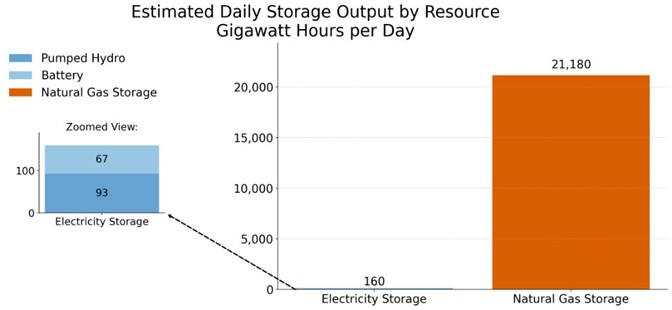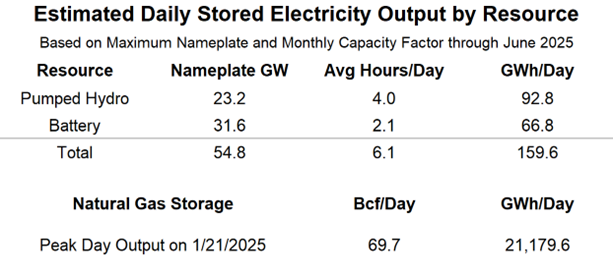Natural Gas Storage is a Critical Balancing Tool Across the Energy Grid

Storage is a critical balancing tool for natural gas utilities during the winter, with a daily dispatch capacity 130x greater than electric storage.
Source: Energy Information Administration, S&P Global Commodity Insights for Gas Storage Data as of Sept 11, 2025. NG output on Jan 21, 2025. Electric output estimated using EIA June 2025 maximum nameplate capacity * maximum daily dispatch capacity.
As the energy system continues to evolve and diversify, natural gas storage remains a cornerstone of energy reliability. Underground natural gas storage is a strategic tool for balancing demand and supplies across time, from seasons to days, helping to ensure the availability of gas supplies and storage capacity, especially when energy needs are highest. During the winter heating season, natural gas storage dispatch capacity is especially critical for system balancing and consumer energy reliability, as thermal loads surge and space heating drives peak demand on the coldest days of the year.
Natural gas storage is built for long-duration, high-volume energy delivery—unlike electric storage, which is designed primarily for short-duration grid balancing. With its flexible, high-capacity energy reserves, underground natural gas storage supports system reliability at output levels that current electric storage technologies cannot match.
Key Findings:
- Underground natural gas storage has a daily dispatch capacity that is more than 130 times greater than current total capacity of all U.S. electric storage systems.
- Combined, pumped hydro and battery storage in the U.S. offer 55 GW in nameplate capacity, delivering an estimated 160 GWh per day. On average, pumped hydro provides an estimated four hours of electric output per day, while battery storage delivers about two hours per day.
- On January 21, 2025, underground storage reached an all-time peak withdrawal of 69.7 Bcf, equivalent to more than 21,000 GWh of energy output. This figure excludes both LNG storage capacity and the maximum daily deliverability of underground storage assets reported by the EIA.
- By 2031, the EIA’s August electric storage forecast anticipates nameplate capacity additions of 137.3 GW for battery storage and 10.4 GW for pumped hydro storage to come online. Assuming all projects are built in this timeline, total daily output would reach approximately 307.3 GWh per day, still falling approximately 70 times lower than the proven energy delivery capacity of the natural gas system.

Source: Based on data from the Energy Information Administration and S&P Global Commodity Insights ©2025, subject to revision
AGA Contact: Lauren Scott, 202-824-7152 Brendan O’Brien, 202-824-7220.
Notice
In issuing and making this publication available, AGA is not undertaking to render professional or other services for or on behalf of any person or entity. Nor is AGA undertaking to perform any duty owed by any person or entity to someone else. Anyone using this document should rely on his or her own independent judgment or, as appropriate, seek the advice of a competent professional in determining the exercise of reasonable care in any given circumstances. The statements in this publication are for general information and represent an unaudited compilation of statistical information that could contain coding or processing errors. AGA makes no warranties, express or implied, nor representations about the accuracy of the information in the publication or its appropriateness for any given purpose or situation. This publication shall not be construed as including advice, guidance, or recommendations to take, or not to take, regarding any matter, including without limitation relating to investments or the purchase or sale of any securities, shares or other assets of any kind. Should you take any such action or decision; you do so at your own risk. Information on the topics covered by this publication may be available from other sources, which the user may wish to consult for additional views or information not covered by this publication.
Copyright © 2025 American Gas Association. All rights reserved.